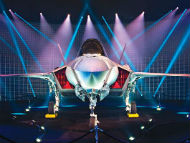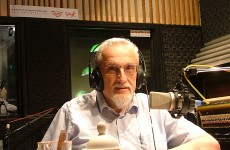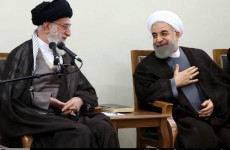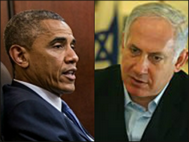
All systems are go for Israel’s Air Force to start operational training on their F-35s, touted to be the top fighter-bomber in the world. Israeli top pilots have long been training on simulators and are eager to get inside the cockpit. Maintenance crews have also been burning the midnight oil studying the myriad of hi-tech that comes with the $100 million price tag (although funded by U.S. military aid). Squadron leader IAF Col. Yotam promises the F-35s will go operational within a year. In addition, the IAF has permission to upgrade the F-35 with secret Israeli improvements – the products of Israeli hi-tech that have proved so effective in the F-15 and F-16. In an unguarded moment, the squadron leader went gung ho saying we’ll make changes the designers never dreamed about and they won’t believe it a year from now.
While only the first two landed at the Nevatim Air base, more and more will be coming. Fifty are now on order. The IAf has dubbed the F-35 in Hebrew by the name of ‘Adir’ – the Mighty. Israel is the first foreign country to be supplied with the F-35. The rest of America’s allies will keep an eagle eye on how successfully the IAF integrates this aircraft. If things go well they can be expected to also start ordering F-35s from Lockheed-Martin. So economically a lot is riding on its going operational in Israel.
Despite the misgivings of President-elect Donald Trump about the high cost and production hitches, the IAF is supremely confident that it will turn out to be all that Lockheed-Martin claims it to be – a breakthrough. In effect, the best fighter-bomber in the world that will prove to be invisible to current detection systems. This is a life and death matter for the Jewish state which is threatened with annihilation by Iran, even though it may have put its nuclear weapons project on hold for the time being. Israel has no doubt the fanatical Ayatollahs will jump start their A-bomb project when they feel the time is right. Israel plans to be prepared when that happens. Now buoyed with the F-35s in the IDF’s arsenal, Prime Minister Bibi Netanyahu issued an updated warning to Tehran when he visited two other Muslim states of Azerbaijan and Kazakhstan. With the F-35s probably in mind Bibi declared Israel was no paper tiger:
‘If Iran attacks Israel it will put itself at risk!’
Although both Azerbaijan and Kazakhstan are overwhelmingly Muslim they are of the ‘lite’ variety and have no truck with terrorism. Actually they are strong trade partners with Jerusalem. Israel imports more than a quarter of its oil from Azerbaijan while Israeli weaponry goes back the other way. Netanyahu even called on Kazakhstan’s President Ilham Heydar Aliyer to support Israel’s candidacy as a non-permanent member of the UN Security Council. Although Israel is one of the oldest UN members, admitted in 1949, it has never been elected to the fifteen-member Security Council.
Consider this: Azerbaijan actually has a border with Iran opening up some intriguing possibilities when it comes to possible military cooperation with the Jewish state.
The IAF has long been the country’s first line of defense and it has risen to the occasion nearly every time. In the War of Independence, Israeli pilots (including Ezer Weizman) flew for the RAF during World War II. Some little known facts: the fledgling IAF had only 25 Czech built fighters that were basically a model of Nazi Germany’s vaunted Messerchmitt-109! Truth may be stranger than fiction and with little to choose from – beggars could not be choosers. But in addition the IAF managed to acquire 62 Spitfires. Many of the pilots were volunteers from overseas both Jewish and non Jewish. And speaking of Spitfires…
IAF – RAF dogfight!
Another interesting fact was that after the Brits pulled out of the British mandate of Palestine, they still kept their finger in the pie. The RAF flew reconnaissance flights at high altitudes over the region. Possibly to pass on the aerial photos to Gen. Glubb Pasha, the British commander of Jordan’s Arab Legion. Then on January 7, 1949 Israeli aircraft shot down four RAF Spitfires followed by a Hawker Tempest on the same day.
Russian missiles defeat Israeli pilots…
In the annals of the Israel Air Force, there was one disastrous failure. Before the Egyptian-Syrian massive surprise attack on October 6th, 1973, Cairo blatantly violated a cease-fire agreement by deploying advanced Soviet supplied SAM (surface to air) missiles near the Suez Canal that separated the IDF and Egyptian armies. Washington, which had brokered the cease fire, pressured Jerusalem not to react. Israel paid very dearly. When the Egyptian and Syrian armies later launched their surprise attacks, Israeli jets took off to support the sparsely manned Israeli positions along the waterway, but they flew into a massive array of SAMs, a virtual curtain of fire that blew Israeli Phantoms and Skyhawks out of the sky. The Arabs had learned the lesson of the Six Day War when the IAF had decimated the air power of Egypt, Syria, Jordan and Iraq within the first hours of battle. They relied on top of the line Russian missiles that took a deadly toll. The IAF had been caught napping, and a surprising number of its jets were shot down in the Suez Canal zone and over the Golan Heights.
Of the IAF’s 390 combat aircraft over 100 were destroyed by the SAMs. But in dogfights, it was a completely different story. Israeli pilots shot down over 170 Egyptian jets while losing only 20 to Egyptian and Syrian aircraft combined. In that war, Israeli pilot Giora Epstein became the greatest ace of the jet era by shooting down his 17th enemy aircraft.
The failure of the IAF to cope with the Soviet missiles sent shock waves through Israel. What went wrong? Israelis believed their pilots were invincible, but Ezer Weizmann later quipped that this time the Soviet missile had ‘bent the wing’ of Israeli jets.
Does today’s evolving situation in the Middle East resemble past developments? Russia has again sent its most advanced SAM-400 missiles to Iran where they protect its nuclear weapons sites. President Putin has also deployed sophisticated SAMs in Syria – they say to defend Russia’s naval and air installations. Again the Israeli Air Force must plan for taking on the Russian-supplied surface to air missiles in any future clashes over Iran or Syria for that matter. In fact, the Russian anti-aircraft missiles in Syria could also threaten Israeli jets flying over Israel.
Let’s look back to 1982, when war erupted between Israel and the PLO in Lebanon. After repeated Palestinian attacks along the Lebanese-Israeli border, PLO terrorists shot Israel’s ambassador in London seriously wounding him. The violence flared into a full-fledged war not with Lebanon but with the PLO, which then dominated the country, in the same way Hezbollah does today.
At the time Syria, the PLO’s patron, had deployed advanced Soviet SAM missiles in Lebanon’s Bekaa Valley threatening IAF jets that were even flying over Israel. Gen. (ret) David Ivri disclosed fascinating details about the air operation that again pitted Israeli aircraft against Russian missiles. Sound familiar? Russia has now sent its most advanced S-400 anti-aircraft missiles to Iran where they have gone operational. The Russians have also stationed SAM missiles in Syria – where they defend Russian air and naval bases. So if today’s evolving situation resembles the events of the First Lebanon War, it is useful to re-examine what happened back then. Who better to do it with than the IAF commander in 1982, Gen. David Ivri. Interviewed by the Yisrael Hayom newspaper, Ivri, himself a former fighter pilot, disclosed many relevant details of how Israeli pilots defeated the SAM batteries on June 9th, 1982:
‘Within 40 minutes we shot down 40 Syrian aircraft without taking any casualties. Within 90 minutes we knocked out every Syrian anti-aircraft battery. In the next two days we shot down a total of 87 Syrian jets without any casualties in the dog-fights. It’s true we had a qualitative edge – American built F-15 and F-16 aircraft compared to the Syrian Mig 21 and Mig 23. But the fact that we shot down so many planes without taking any casualties of our own, and particularly our success in destroying all the Soviet SAM batteries, again without any casualties of our own was surprising. The Syrians were surprised, the Russians were surprise, the whole world was surprised’.
The IAF’s achievement in 1982 against the Soviet SAMs was beyond a military victory. It changed the perception on a global level. After the Yom Kippur War in 1973 and after Vietnam the world thought that surface to air missiles restrict the aircraft’s ability to operate. Also in Israel there was a feeling that an answer had been found to cope with Israel’s air superiority. That our air force had lost its capability to protect clean skies. After the Yom Kippur war they took the best manpower from us, cut our budgets. The question was asked if the Air Force could cope with regional threats. Therefore the victory in Lebanon over the Russian missiles was so important to restore our rightful place.
What was the secret of the IAF’s success?
Gen Ivri: ‘It was a turning point in the use of air power. A breakthrough. It was the first war in history that air power was activated in a modern integrated manner. Inside my command post I could follow the attack on TV. We had aerial means that gave us an accurate picture of the battle. We even had better intelligence of the Syrian side than the Syrians had themselves. I saw the electronic flashes of the SAM batteries start going out one after another as they were being destroyed by our aircraft. We succeeded to such an extent because we were well prepared – we were prepared for that war; not for the previous war’.
Did the IAF use any secret weapon that won the day?
‘The tactics we activated provided us for the first time with the opportunity to launch precisely a bomb at a specific target, through the window of a house as they say; the blinding of their radar prevented the Syrian control system from directing their aircraft, as did accurate intelligence. All these elements gave us a certain advantage. But only the activating of an integrated system, of all the components, truly gave us the victory’.
What is obvious is the IAF must also have found a method for defanging the Soviets’ top SAM system at the time. All 19 of the Soviet missile batteries deployed in the Bekaa Valley were left in piles of rubble.
And a personal note: several days after the spectacular IAF air strike I interviewed IDF Gen. (ret) Haim Herzog, who had served as commander of the Intelligence Corps. Herzog said the IAF’s destruction of the Soviet anti-aircraft system had sent shock waves not only through the Soviet Union but also the entire Warsaw Pact! The reason being that they were defended by the same anti-aircraft missiles that Israeli pilots had demolished within a few hours and without suffering any losses. If Israel had cracked the SAM missile shield, this meant that the know-how would be passed on the next day to Israel’s ally, the U.S. In other words, the Israeli Air Force had stripped the Soviet Union of its air defense! This reportedly impacted on Mikhail Gorbachev’s decision to later launch his Glasnost policy for reconciliation with the West.
This brings the wheel full circle to the scenario that Israeli pilots flying American jets may again have to take on Russian SAM missiles defending Iranian nuclear sites, if and when Tehran breaks out for A-bombs.




